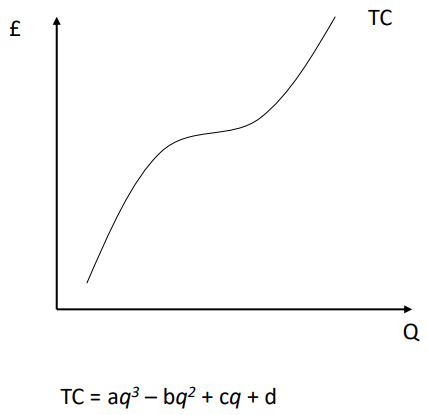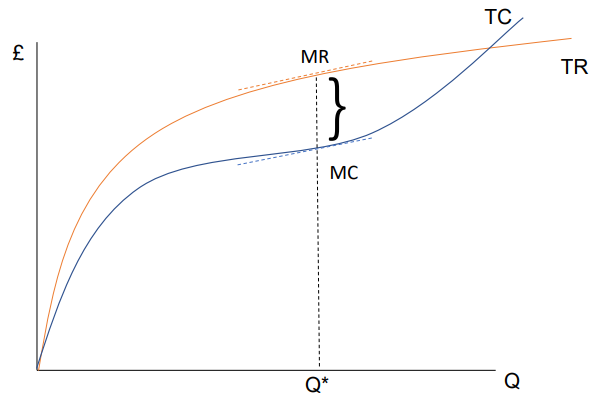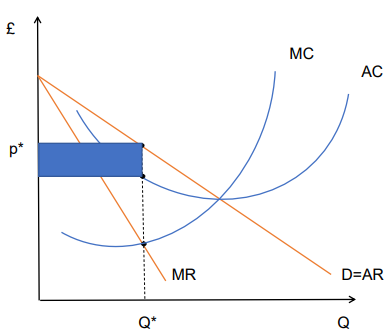Perfect and Imperfect Competition
1/20
There's no tags or description
Looks like no tags are added yet.
Name | Mastery | Learn | Test | Matching | Spaced |
|---|
No study sessions yet.
21 Terms
Perfect Competition
Many buyers, no one of which is large relative to the overall market
Many sellers, no one of which is large relative to the overall market
The outputs of different sellers are homogeneous (products are exactly the same)
Buyers are well informed about the offerings of competing suppliers
Neither technological nor legal barriers to entry exist
Imperfect Competition
In most situations, firms can differentiate their products from those of their competitors
Many firms are price setters - they have at least some latitude to set their own prices
They have market power – they have the ability to raise the price of a good without losing all of its sales
Perfect Competiton vs Imperfect Competition
Perfect competition:
Demand curve is perfect elastic - no matter how many units of product the firm produces, the market price won’t be affected at all
If price increases you may lose all customers
Price taker
Imperfect competition:
Demand curve is downwards sloping - if output level increases, market price decreases
If price increases you will not immediately lose all consumers
Price setter

Forms of Imperfect Competition
Pure Monopoly
Oligopoly
Monopolistic Competition
Pure Monopoly
A market in which a single firm (monopolist) is the only seller of a unique product. It is the polar opposite to perfect competition
Oligopoly
A market structure in which only a few firms (oligopolists) sell a given product
Monopolistic Competition
Competition consists of a relatively large number of firms that sell the same product with slight differentiations
Monopoly
Many buyers, no one of which is large relative to the overall market
One seller
There are no close substitutes
Buyers are well informed about the offerings of competing suppliers
Either technological or legal barriers completely block entry
Relationship between Average and Marginal Revenue in Monopoly
Marginal revenue has same intercept but slope is twice as deep as average revenue
If given average revenue and need marginal revenue just multiply gradient by 2
Marginal Revenue when Total Revenue is Maximised
= 0
If producer makes more the marginal revenue will be negative
Less money - total revenue will drop
Total Revenue
Given by average revenue times quantity sold, TR = aq – bq^2
Marginal Revenue
Given by the rate of change of total revenue with respect to quantity sold (differentiation)
MR = d(TR)/d(q)
Total Cost Graph
The shape is determined by the law of diminishing marginal product (in the short run) and by economies and diseconomies of scale (in the long run)
Typically an inverse-S shape
More you produce - more total cost you have
The more you produce the less you need to pay per unit of product up to a certain point where it increases again

Marginal Cost Graphically
always intersect the minimum point of the average cost
if its below average cost the average cost decreases
if its above average cost the average cost increases
Profit Maximisation
When marginal revenue = marginal cost profit can be maximised
Profits are maximised where TR>TC and the vertical distance between TR and TC is greatest
Find this at the point where the TR slope = TC slope, where they are in parallel
TR slope = marginal revenue
TC slope = marginal cost
Therefore when they are equal is where profit is maximised

Why is Monopoly Inefficient
Demand curve: quantity = Q* and price = p*
Total revenue = p* Q
Total cost = AC (at Q*) Q
Profit = total revenue - total cost (blue rectangle)
there is no profit therefore no producer surplus
larger than the total surplus (consumer surplus + profit in monoploy)
therefore monopoly is ineffient as it has less overall surplus/profit

Price Discrimination
the case where customers are charged different prices for the same good
Conditions necessary for it to be profitable:
The firm must be a price maker
The firm must be able to identify which consumer is which
Consumers must not be able to arbitrage
Arbitrage
The process whereby customers to whom the firm charges low price make purchases that they then resell to customers who would otherwise have to pay high prices
First Degree Price Discrimination (Perfect Price Discrimination)
The monopolist knows exactly the willingness to pay of each consumer in the market
It then sell each unit of output at a price just equal to the buyer’s maximal willingness to pay for that unit
Everyone ends up paying a different price for the same product
Efficient in the way that the producer gets all the surplus - no consumer surplus
Second Degree Price Discrimination
The monopolist knows that its customers have different willingness to pay but it can’t tell who is who
The same price schedule is offered to all buyers but they sort themselves through self selection
E.g. hiding promo codes only for people who are willing/have time to search online for them
Third Degree Price Discrimination
The monopolist does not know each consumer’s willingness to pay. Instead, the monopolist sees an observable characteristic (such as age, gender, race, and so on) of its consumers that is related to their willingness to pay
The monopoly then charge different prices based on these
E.g. charging older people more than younger people as they stereotypically have more money - 18-25 railcard discounts